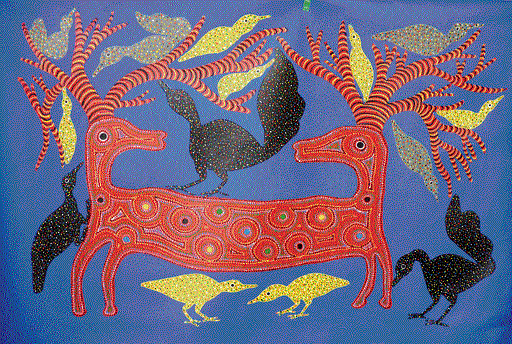
One of the most primitive art forms in India, Bhil paintings have gained global acclaim. Brinda Suri speaks to Bhil artists and patrons about the origins of the art form and its gradual growth.
Bhil art is possibly the oldest form of tribal expression in India. On the contemporary art scene, though, it’s been a late starter, having been overshadowed by other forms which, perhaps, got promoted better. Renowned Bhil artists like Bhuri Devi were discovered a few decades ago, but despite them being hailed by aficionados internationally, their popularity was restricted to a small audience. The reason the art remains delightfully folkish even as it now begins enjoying the spotlight.
For the record
To an untrained eye, Bhil can be confused for Gond, both art forms use near-similar metaphor. But look a little keenly — you don’t need to peer too hard — and you’ll realise the marked differences between the two figurative styles.
With the sort of urban exposure it’s received, Gond has refined itself. What’s clearly visible at first glance are the contours in Gond paintings, which are well defined. For instance, if the paws of a cat are to be shown, these will resemble the actual shape. In a Bhil painting, on the other hand, they will be just an impression.
In-filling the motif is a prominent aspect of both forms. Bhils use only dots in all colours and these can be scattered or drawn in neat formation, almost similar to aborigine art. In contrast, each Gond artist has evolved a signature filling pattern — dot, dash, round etc — and these are almost-always in the colour black.
Furthermore, the art of the Gonds is usually proportionate, while the Bhils have an unrestrictive, almost naïve, style.
Continental connection
“Bhil, Gond, Rathwa are tribes found in the neighbourhood of western Madhya Pradesh and eastern Gujarat. Their culture and customs have similar basis, which gets reflected in the paintings of each of these communities. It’s the approach that differs,” says Mamta Sharma, senior manager, Tribal Co-operative Marketing Development Federation of India Limited (Trifed), Ministry of Tribal Affairs. “Quite intriguingly, the similarity of form found in these tribal paintings is noticeable in aboriginal art too. A few seasons back, we had held an exhibition of Gond and aborigine art from Australia; it was hard to tell them apart,” she avers, bringing the focus back once again to the ongoing debate on how best to explain the parallel connection between two art forms indigenous to two separate continents. Throwing light on this, a recent anthropological research suggests that during the great migration, particular genetic groups reached Australia via the Gond region in India. These groups possibly picked up the art form here and took it with them to where they finally settled and developed it into what’s today known as aborigine art.
Leading light
Most Bhil artists look up to Bhuri Bai of Pitol in the Jhabua district, Madhya Pradesh. Celebrated for her creativity, she was the first to switch to paper, having spent her early years customarily decorating house walls. She drew, as do all tribals, the relationship between man-nature, the animal kingdom, and episodes from village life. So birds took wings, the peacock preened, the crow sat on the buffalo, families walked home from the fields and simple joys like births and bumper harvests called for community celebrations. All bucolic and innocent.
Her imagination soared with the shift to Bhopal and further global wanderings made the aeroplane fly over a hut and the cellphone become the presiding deity of the village. It’s the harmonious incorporation of new elements into the matrix even as the originals continue to co-exist in their own form, making this genre of art so vibrant. Other artists who have become names to reckon with include Gangu Bai, Jor Singh, Subhas Bhil and Anita Baria.
Promoting art
Agencies like Trifed, that does retail marketing of tribal products under the brand name Tribes India, have been a catalyst in popularising tribal art, apart from providing a steady source of livelihood to many emerging ones. “Through word of mouth, Trifed has become a platform for tribal artists. They bring their work to us and a panel of experts judges it. On the basis of their decision, we set the price of the paintings. Though there are many artists today, in a bid to make an instant mark, and the quick buck, they tend to forget that quality speaks. Earlier, we would reject some work outright but now we simply scale down the price in an effort to not discourage the artist,” explains Sharma. Whether you are a collector or an investor, Bhil art may well be a valuable option.